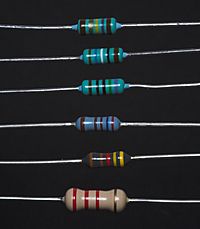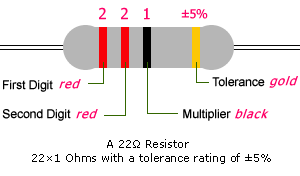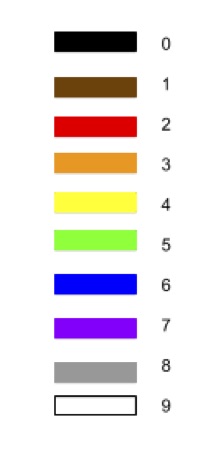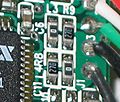Resistor facts for kids
A resistor limits the electrical current that flows through a circuit. Resistance is the restriction of current. In a resistor the energy of the electrons that pass through the resistor are changed to heat and/or light. For example, in a light bulb there is a resistor made of tungsten which converts the electrons into light.
Contents
Series and parallel
Resistors can be linked in various combinations to help make a circuit:
- Series - Where the resistors are linked one after another.
- Parallel - Where the resistors are linked over one another.
There are many different types of resistors. Resistors have different ratings to tell electricians how much power they can handle before they break and how accurately they can slow the flow of electricity. Connecting two resistors in series results in a higher resistance than when you connect the same two resistors in parallel. To prevent the resistor from reaching its capacity, place the resistors in parallel to keep the total resistance lower. Nowadays the electrical industry in many cases uses so called surface-mount technology based resistors which can be very small.
Calculating resistance
- Series Circuit: Rt=R1+R2+R3+R4...Rn
- Parallel Circuit: 1/Rt=1/R1+1/R2+1/R3...1/Rn
Where R is the resistor's value
Ohm’s Law
The formula for Ohm’s law, V=I*R, states that the voltage drop across a component is equal to the product of the current flowing in the component multiplied by the resistance of the component. When using Ohm’s law, you are able to switch the formula around if needed to find a different outcome: I=V/R or R=V/I
Color code
Resistor's values are rated by the colors that are listed on the side of the resistor. The colored bands that are used on the sides of a resistor are black, brown, red, orange, yellow, green, blue, purple, gray, and white. Each color represents a different number. The black band represents the number 0, brown band represents the number 1, red is 2 and so on all the way to white which is the number 9. These numbers are very important in the electronic field.
A resistor can have multiple bands of color on its side. The most common have four but they can range all the way up to 6 per resistor. On a four band resistor, the last band is gold or silver. The gold band represents a positive or negative 5% tolerance. The silver band on a resistor represents a positive or negative 10% tolerance. Hold this band on the right side, and read the colors from left to right. The first two bands are read as the numbers that they represent in the color code. The third band acts as a multiplier for the other bands, so for example, if the third band was a orange band which is a 3, it would mean you multiply the two numbers by 1000. In short you add the value of the color in zeros at the end, so add three zeros.
Applications
Resistors are used in many different ways. First of all, they are put in circuits to protect components from damage such as LEDs. They also control the amount of current flowing in a circuit, for example, if you want the current to be slowed you would add more resistors to create more resistance in the circuit. Resistors can also split voltage between different parts of a circuit and control time delay.
Resistor materials
There are many different types of resistors you can find. They are all made with a resistance material encased in a non-conductive material casing, such as plastic. Fixed resistors are usually made of carbon encased in a plastic cylinder, with a connecting wire on either end. Most resistors used in electronics today are carbon resistors. Older resistors were made of a poorly conducting metal, in order to restrict the flow of electricity.
Images for kids
-
Three carbon composition resistors in a 1960s valve (vacuum tube) radio
-
An assortment of small through-hole potentiometers designed for mounting on printed circuit boards.
-
Resistance decade box, made in former East Germany.
-
This image shows four surface-mount resistors (the component at the upper left is a capacitor) including two zero-ohm resistors. Zero-ohm links are often used instead of wire links, so that they can be inserted by a resistor-inserting machine. Their resistance is negligible.
See also
 In Spanish: Resistor para niños
In Spanish: Resistor para niños























